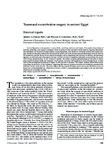|
|
Creator | Title | Description | Subject | Date |
| 301 |
 |
Couldwell, William T. | Technique for methyl methacrylate cranioplasty to optimize cosmetic outcome | Background: Cranioplasty aims to reconstruct skull defects from fractures, decompressive craniectomies, tumors, and congenital anomalies in a cosmetically acceptable manner. We present a technique in methyl methacrylate cranioplasty that gives excellent cosmetic results by maintaining patient's calv... | | 2014-01-01 |
| 302 |
 |
Swallow, Charles E.; Tsuruda, Jay S.; Digre, Kathleen B.; Glaser, Matthew J.; Davidson, H. Christian; Harnsberger, H. Ric | Terson syndrome: CT evaluation in 12 patients. | PURPOSE: Terson syndrome may be overlooked in the acute setting and often requires ophthalmologic intervention to prevent long-term visual loss. In this syndrome, vitreous or retinal hemorrhage results from an abrupt rise in intracranial pressure, leading to retinal venous hypertension and intraocul... | Retinal Hemorrhage; Visual Acuity; Vitreous Hemorrhage | 1998-04 |
| 303 |
 |
Couldwell, William T. | The frontotemporal (Pterional) approach: an historical perspective | The frontotemporal, so-called "pterional" approach has evolved with the contribution of many neurosurgeons over the past century. It has stood the test of time and been the most commonly used transcranial approach in neurosurgery. In its current form, drilling the sphenoid wing as far down as the su... | | 2012-01-01 |
| 304 |
 |
Dailey, Andrew T. | Thoracolumbar spine trauma classification: the Thoracolumbar Injury Classification and Severity Score system and case examples | Object. The aim of this study was to review the Thoracolumbar Injury Classification and Severity Score (TLICS) and to demonstrate its application through a series of spine trauma cases. Methods. The Spine Trauma Study Group collaborated to create and report the TLICS system. The TLICS system is re... | Thoracolumbar spine trauma; Classification; Thoracolumbar injury; TLICS; Spine Trauma Study Group; Thoracolumbar Injury Classification and Severity Score | 2009 |
| 305 |
 |
Schmidt, Meic H. | Thoracoscopic debridement and stabilization of pyogenic vertebral osteomyelitis | The role of surgical debridement and internal fixation in treatment of vertebral osteomyelitis has been evolving. The standard surgical approach to thoracolumbar vertebral osteomyelitis requiring extensive thoracotomy or retroperitoneal exposure carries significant associated morbidity and postoper... | | 2007-01-01 |
| 306 |
 |
Schmidt, Meic H. | Thoracoscopic spine surgery for decompression and stabilization of the anterolateral thoracolumbar spine | The anterior thoracolumbar spine can be exposed via a variety of approaches. Historically, open anterolateral or posterolateral approaches have been used to gain access to the anterior thoracolumbar spinal column. Although the exposure is excellent, open approaches are associated with significant pa... | Endoscopic spinal surgery; Thoracic spine; Lumbar spine; Thoracoscopic spinal instrumentation | 2005 |
| 307 |
 |
Schmidt, Meic H. | Thoracoscopic vertebral body replacement with an expandable cage after ventral spinal canal decompression | OBJECTIVE: Minimally invasive thoracic anterior surgery using a thoracoscopic approach has evolved to include spinal biopsy, debridement, discectomy, decompressive corpectomy, interbody fusions, and internal fixations. Minimal access techniques can potentially decrease surgical access morbidity and... | | 2007-01-01 |
| 308 |
 |
Couldwell, William T. | Thrombosed Basilar Apex Aneurysm presenting as a third ventricular mass and hydrocephalus: case report and review of the literature | Aneurysms presenting as third ventricular masses are uncommon; most are giant aneurysms arising from the basilar apex. We present a case of a thrombosed basilar apex aneurysm presenting as a third ventricular mass and hydrocephalus in a 55-year-old man. The case is unique in the literature as the an... | Basilar Apex Aneurysm; Ventricular Mass; Third Ventriculostomy | 2005-04 |
| 309 |
 |
Couldwell, William T. | Thrombosed basilar apex aneurysm presenting as a third ventricular mass and hydrocephalus | Aneurysms presenting as third ventricular masses are uncommon; most are giant aneurysms arising from the basilar apex. We present a case of a thrombosed basilar apex aneurysm presenting as a third ventricular mass and hydrocephalus in a 55-year-old man. The case is unique in the literature as the an... | Basilar apex aneurysm; Ventricular mass; Third ventriculostomy | 2005 |
| 310 |
 |
Dailey, Andrew T.; Brodke, Darrel S. | Timing and influence of MRI on the management of patients with cervical facet dislocations remains highly variable: a survey of members of the Spine Trauma Study Group | Background: Traumatic cervical facet dislocations are potentially devastating injuries. Magnetic resonance imaging (MRI) is an excellent means of assessing ligamentous disruption, disk herniation, and compression of the neural elements. However, despite an improved understanding of these facet dislo... | Cervical facet dislocations; MRI; Spine Trauma Study Group | 2009 |
| 311 |
 |
Schmidt, Meic H. | Titanium cage-assisted polymethylmethacrylate reconstruction for cervical spinal metastasis | Reconstruction and stabilization of the cervical spine after vertebrectomy is an important goal in the surgical management of spinal metastasis. The authors describe their reconstruction technique using a titanium cage-Silastic tube construct injected with polymethylmethacrylate (PMMA) augmented by... | Titanium cage; Cervical spine; Cervical spinal metastasis; Reconstruction; Vertebrectomy; PMMA reconstruction; Silastic tube | 2005 |
| 312 |
 |
Couldwell, William T.; Gottfried, Oren N. | Too many? Too few. New study reveals current trends in U. S. neurosurgical workforce | Remarkable changes in the neurosurgical specialty have taken place in the past 15 years. While advances in basic science have occurred and new technologies and therapies have proliferated, other, less propitious factors-such as the promises (some might say false promises) and hopes of managed care-h... | | 2003-01-01 |
| 313 |
 |
Couldwell, William T. | Total intravenous anesthesia: advantages for intracranial surgery | Although volatile anesthetics have been widely accepted in anesthetic management for neurosurgery, they reduce vascular resistance, resulting in increased cerebral blood flow and increased intracranial pressure (ICP). In patients with elevated ICP who undergo craniotomy, the increase in ICP during s... | Anesthesia; Inhalants; Intravenous; Propofol; Intracranial surgery | 2007 |
| 314 |
 |
Kestle, John R. W. | Tracking resident work hours: available software is not yet ideal, but it's helpful | An ideal system would be completely passive and would allow more detailed tracking of activity inside the hospital. A new reality began July 1. We are all now responsible for tracking our residents' work hours and ensuring compliance with the new regulations mandated by the Accreditation Council fo... | Resident work hours; Tracking; TimeClock system | 2003 |
| 315 |
 |
Couldwell, William T. | Transfacet pedicle-sparing approach for thoracic disc removal: cadaveric morphometric analysis and preliminary clinical experience | A number of operative techniques have been described for the treatment of herniated thoracic discs. The transfacet pedicle-sparing approach allows for complete disc removal with limited spinal column disruption and soft-tissue dissection. Fifteen cadaveric spinal columns were used for evaluation of... | Thoracic spine; Herniated thoracic discs; Intervertebral disc herniation; Discectomy; Pedicle; Radiculopathy; Myelopathy | 1998 |
| 316 |
 |
Couldwell, William T. | Transmaxillary approach to the anterior cavernous sinus: a microanatomic study | OBJECTIVE: Several approaches to expose the anterior cavernous sinus have been used, such as frontotemporal, orbitofrontal, anterior subtemporal, and various transfacial approaches. In an effort to gain exposure to the anterior cavernous sinus without necessitating a craniotomy or wide transfacial ... | Anterior cavernous sinus; Clivus; Cranial base; Maxillary sinus | 1997 |
| 317 |
 |
Couldwell, William T. | Transnasal excerebration surgery in ancient Egypt: Historical vignette | Ancient Egyptians were pioneers in many fields, including medicine and surgery. Our modern knowledge of anatomy, pathology, and surgical techniques stems from discoveries and observations made by Egyptian physicians and embalmers. In the realm of neurosurgery, ancient Egyptians were the first to elu... | | 2012-01-01 |
| 318 |
 |
Couldwell, William T.; Apfelbaum, Ronald I. | Transoral approach and extended modifications for lesions of the ventral foramen magnum and craniovertebral junction | Objectives: To describe our method of performing the transoral approach and the extended approaches to the ventral foramen magnum and craniovertebral junction and review the technical aspects and operative nuances. Design: Review Results: The transoral approach provides direct midline exposure to a... | Craniovertebral junction; Foramen magnum; Skull base surgery; Transoral approach | 2008 |
| 319 |
 |
Couldwell, William T. | Transsphenoidal microsurgical treatment of Cushing disease: postoperative assessment of surgical efficacy by application of an overnight low-dose dexamethasone suppression test | Object. Transsphenoidal adenomectomy with resection of a defined pituitary adenoma has been the treatment of choice for CD for the last 30 years. Surgical resection, however, may not always result in long-term remission of CD. This is particularly important in light of the high risk of morbidity and... | | 2003-01-01 |
| 320 |
 |
Couldwell, William T. | Transtemporal approach to the removal of a lateral pontine tumor | This video demonstrates a very useful trajectory to a pontine lesion. A 68-year-old man presented with tongue numbness and weakness. The approach used was a transtemporal presigmoid retrolabyrinthine approach to enable an orthogonal trajectory to the lateral pons. Following the transtemporal opening... | | 2014-01-01 |
| 321 |
 |
Schmidt, Meic H.; Kestle, John R. W. | Treatment of metastatic spinal epidural disease: a review of the literature | Object. Spinal cord compression is one of the most dreaded complications of metastatic cancer. It can lead to a number of sequelae, including pain, spinal instability, neurological deficits, and a reduction in the patient's quality of life. Except in selected circumstances, treatment is palliative. ... | Spinal cord compression; Metastasis; Radiation therapy; Stereotactic radiosurgery | 2003 |
| 322 |
 |
Jensen, Randy Lynn | Treatment-related brain tumor imaging changes: so-called "pseudoprogression" vs. tumor progression: Review and future research opportunities | Background: Glioblastoma multiforme (GBM) has a dismal prognosis despite aggressive therapy. Initial diagnosis and measurement of response to treatment is usually determined by measurement of gadolinium-enhanced tumor volume with magnetic resonance imaging (MRI). Unfortunately, many GBM treatment mo... | | 2013-01-01 |
| 323 |
 |
Couldwell, William T. | Trends in the neurosurgical workforce in the United States (Neurosurgical workforce trends in the United States) | OBJECT: The purpose of this study was to evaluate the US neurosurgery workforce by reviewing journal recruitment advertisements published during the past 10 years. METHODS: The number of available academic and private neurosurgical staff positions was determined based on recruitment advertisements i... | Advertising; Internship and Residency; Neurosurgery; Personnel Selection | 2005-02-01 |
| 324 |
 |
Couldwell, William T.; Davidson, H. Christian | Trigeminal amyloidoma: case report and review of the literature | The authors present a case of amyloid infiltration involving the trigeminal nerve that mimicked a malignant cavernous sinus tumor with perineural tumor infiltration. A 64-year-old man presented with trigeminal nerve numbness. Imaging revealed a plaque-like enhancing lesion along the right lateral ca... | Gasserian ganglion; Trigeminal; Amyloidoma | 2007 |
| 325 |
 |
Couldwell, William T. | Tunneled lumbar drain | The authors report a simple and rapid procedure for tunneling a lumbar drain subcutaneously to facilitate chronic cerebrospinal fluid (CSF) drainage. A standard lumbar puncture (LP) is performed with a large-bore Tuohy needle (14- to 16-gauge), the drainage catheter is advanced into the subarachnoid... | Lumbar drain; Fistula | 2002 |

























